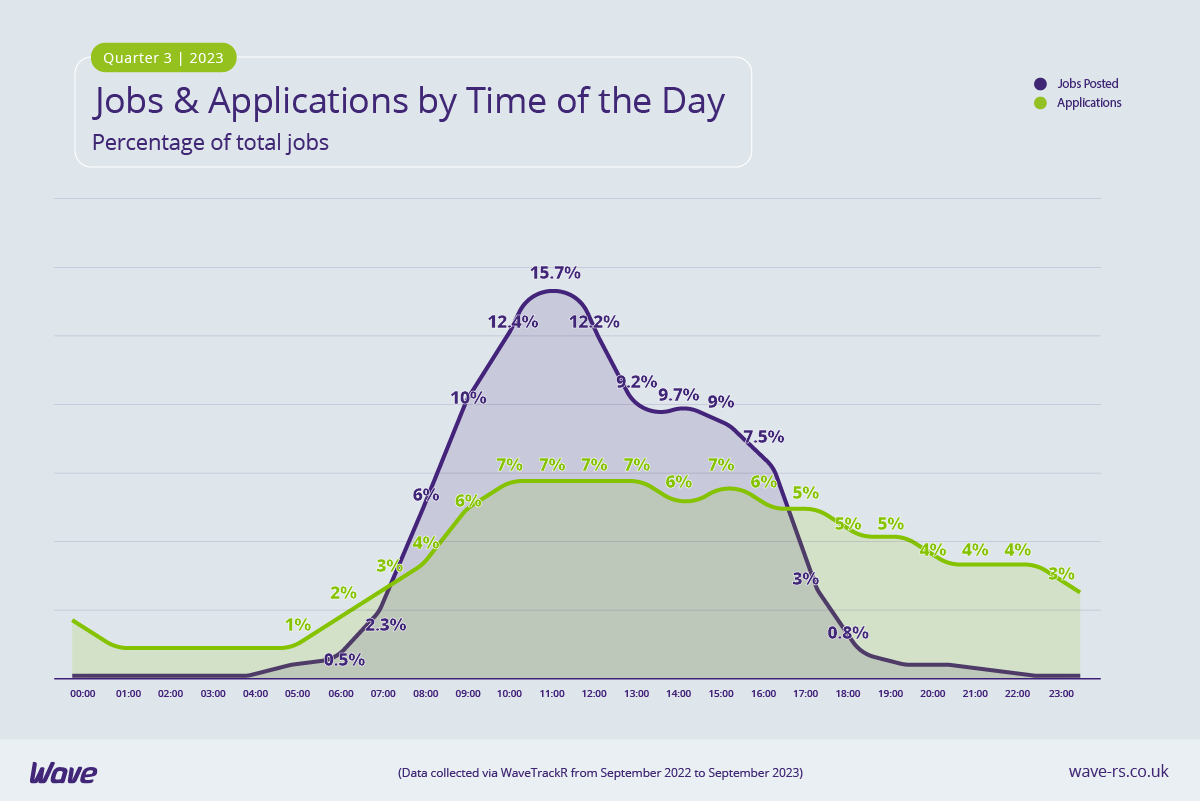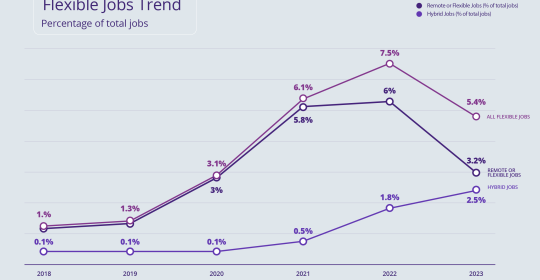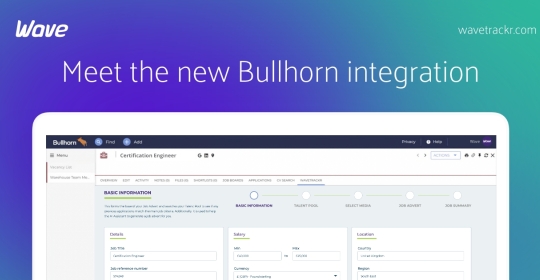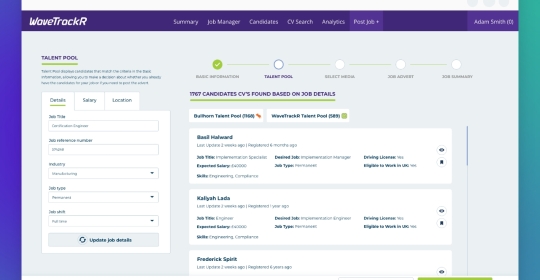The faster you can get a job ad out or run a successful CV search, the more likely you will reach talented candidates before your competitors do. The faster the hiring process, the less likely a candidate will drop out having been lured by another job. The faster your time to hire rate, the happier your clients will be and the faster you can move focus to your other roles.
Time is also crucial when it comes to when to post your jobs. You need to be getting your ads in front of candidates when they are actively searching and applying. Post at the wrong time and you could miss qualified candidates while your job ad falls down the search results page as the algorithms promote fresh content first. What does this mean in practical terms?
You need to know when candidates are searching for jobs in order to know when to post yours. Newly published data in the Wave Q3 2023 Recruitment Trends Report reveals when most applications are received as an average across all industries and at an industry-specific level. The data has also found that scheduling your job posts rather than posting them right away nets you close to double the applications - makes sense if you know when candidates are actively searching. And Wave’s time to apply data provides further proof that time really is of the essence.
Applications are received shortly after jobs are posted
Our data shows that, for both weekly and 6-week listings, the majority of applications were sent soon after the job was posted. For 7-day listings, 25% of applications were received within 24 hours of a job being posted and 23% were received within 48 hours. The numbers drop off with each passing day. For listings of 30-42 days, the highest percentages were received within 48 hours, significantly dropping off as the month progresses.
Why does this happen and why does it matter? Applications are received soon after a job is posted largely because fresh jobs are posted constantly on job boards so the more time that passes after a job has been posted, the less likely it is that candidates will see it as the algorithms prioritise fresh content. In order to ensure your job is newly posted when candidates are actively searching, it’s vital to post at the right time.
As job boards prioritise newer jobs in organic searches, you need to post your jobs on the day that the majority of candidates apply. Post them after the greatest amount of candidate activity has occurred and it could be days before candidates visit the job board, by which point your job will be further down the search results. This could mean the difference between your job being posted on page 1 or 21 when qualified candidates are looking.
Scheduled jobs result in increased applications
As an average across all industries, the number of applications per scheduled job is 27 in comparison to the 15 received for unscheduled jobs. That’s an average of 12 more applications per job and a huge percentage increase of 80% if you schedule a job rather than post it straight out. At a more granular, industry-specific level, these numbers vary (as the report shows) but the majority experience a significant uplift in applications for scheduled jobs. For Travel, Leisure & Tourism, for example, the average number of applications jumps from 14 for unscheduled jobs to a massive 109 for scheduled jobs.
It can be incredibly tempting to get your jobs out as soon they’re written (that time pressure ticking away in your brain!) but what this points to is the huge advantage of posting jobs at the right time, not necessarily the fastest time - and this can be easily done by scheduling your jobs. But how do you know what the right time is? See below!
Peak candidate activity occurs at the beginning of the week
Our data shows that the highest percentage of applications are received on Mondays and Tuesdays, with that percentage slowly dropping as the week wanes. This is a trend that we have observed for several years, dispelling the myth that candidates apply for jobs over the weekend. In fact, just 9% of applications are received on Saturdays and Sundays compared to 18% on Mondays and Tuesdays. You can see why scheduling your jobs to post at the times when candidates are actively searching for jobs will lead to an uplift in applications - if you post a job on a Friday, a full three days before most candidates are online and looking for jobs, they may not even see your advert.
Candidates apply at the beginning of the working day
The majority of candidates are applying for jobs between 10am and 1pm and not after work hours. They could be job searching and applying in their lunch hour and, with so many working from home at least part of the week, they could be taking a break mid-morning to send in an application. What this indicates is that jobs should be scheduled to post early morning, at 8am or 9am, so that they are up just before the majority of candidates are applying. What our data shows is that most jobs are posted at 11am but posting at that time could miss a number of candidates who are active at 10am.
Best time to post: industry specific
We take seven industries and drill down to find the best days and times to post your jobs in each one.
IT & Internet
Day - Monday and Tuesday are the two most popular days for applications, with Wednesday and Tuesday just behind. Applications drop off by Friday and Saturday sees the lowest percentage. Sunday receives slightly more applications, perhaps as candidates get the Sunday night dread of starting another week in a job they dislike. However, the majority of jobs are posted on a Wednesday, with Monday seeing the least amount of jobs posted over the working week so there is a disconnect here between when candidates are most active and when jobs are being posted.
Time - Application times are similar to the general all-industry data, though with a slight majority at 12pm. Job posting times are fairly specific, with the majority of jobs being posted over three time periods. Just over 34% of jobs are posted at 11am, followed by nearly 29% at 12pm and 11.2% at 10am. This tallies well with applications, meaning that the majority of jobs are posted just before or at the same time that many candidates are looking.
Health & Nursing
Day - Health & Nursing bucks the general trend by receiving a relatively high percentage of applications on a Sunday. 14% of all applications are received on Sundays, higher than Saturday and Friday, level with Thursday and only just under Wednesday. This could be because of the shift pattern nature of many Health & Nursing jobs but indicates that more jobs should perhaps be posted on a Sunday - currently only 0.5% are. The vast majority of jobs are posted on Mondays, which, jointly with Tuesdays, are when the majority of applications are received. However, those searching and applying on a Sunday will find it harder to find jobs that are posted nearly a week prior.
Time - The highest percentage of applications are received at 12pm but candidates are fairly consistently active throughout the day from around 9am and into the evening until 9pm. In fact, application activity continues right into the night. Again, this is likely due to the shift nature of many roles in the industry. The majority of jobs are posted from 9am to 11am, which tallies well with when the bulk of the application activity begins.
Manufacturing
Day - Most applications are received on Mondays and Tuesdays and they gradually drop off as the week progresses. However, Saturday and Sunday still see activity, receiving 10% of the total each. This is helped by the fact that more jobs are posted on Fridays than Mondays - going against the all-industry trend - however, as Mondays are the joint busiest days for applications, there is a strong case for scheduling more jobs for Mondays. As it stands, the fewest jobs in the working week are posted on Mondays, with Fridays just over. Wednesdays and then Thursdays top the week for jobs posted, which doesn’t tally with application activity.
Time - The majority of applications are received around lunchtime but activity is fairly consistent across the day, from 9am up until around 9pm. Job posting times are rather sporadic, with the majority in the afternoon and peaking at 4pm. Just 6.9% of jobs are posted at midday, part of the peak time period for applications.
Education
Day - The majority of applications are received on a Monday and Tuesday, slowly decreasing as the week wanes. However, only 17% of jobs are posted on a Monday - the smallest amount of any weekday (barring the weekend). On Tuesdays job posting ramps up to 23.1%, the highest all week, which tallies with the high applications on that day but misses the Monday applications rush. A relatively high 18% of jobs are posted on a Friday but only 10% of applications are received on each day of the weekend.
Time - Applications follow the general trend of peaking mid-late morning and over lunchtime but with a steady stream over the afternoon and early evening. However, the majority of jobs are posted at 2pm, with lower percentages in the peak application time of between 11am and 1pm.
Secretarial, PAs & Admin
Day - Monday is the most active day for applications but Tuesday to Thursday have similar percentages. From Friday and into the weekend they drop off considerably. The job posting data doesn’t quite match up, with Monday one of the least active days of the week for jobs. The majority of jobs are posted on Wednesdays, followed by Thursdays. In order to catch more candidates while they’re actively searching for jobs, more job posting on Mondays would be advisable.
Time - 10am to 3pm is the most active time period for candidates but applications continue into the evening. As the majority of jobs are posted at 10am this aligns nicely. The active posting period begins at 8am and see-saws until 4pm, after which it drops off considerably.
Public Sector & Services
Day - Bucking the general trend, Monday is not the most active day for applications. In fact, receiving 16% of all applications, it is only the third most active day of the week, behind Tuesday (the most active at 20%) and Wednesday (18%). Post-Wednesday, the figures drop as we head towards the end of the week and the weekend. Most jobs were posted on a Wednesday, fairly late in the week to catch candidates searching at the beginning of the week, and the second busiest day for jobs is Friday - the weekday with the fewest applications and right before the weekend with a sharp drop in applications.
Time - The majority of applications are received not around lunchtime like many other industries but at 3pm. The second highest percentage of jobs are also posted at that time, but a relatively low percentage are posted at midday, which is within a busy time period for candidates.
Engineering
Day - Like many industries, the majority of applications for Engineering jobs are received at the beginning of the week, on Mondays and Tuesdays, declining through the week. However, Monday is the least active weekday for job posting. Just 15.9% of jobs are posted on a Monday compared to 22.7% on a Tuesday, 22.1% on a Wednesday, 19.5% on a Thursday and 17.4% on a Friday - the latter just before the weekend which receives far fewer applications.
Time - 10am-1pm is the most active time for candidates but applications keep coming in similar numbers up until early evening. In comparison, fewer jobs are posted in the time period between 11am and 1pm than at any time within the 8am to 4pm bracket.
Wave’s data on time proves that using a tool to schedule jobs to post at the right time has a huge effect on applications. It can be hard to override that feeling that you need to get your jobs out as soon as the ads are ready but the pay-off for waiting until candidates are actively searching can be a massive uplift in the applications you receive. Whatever the next quarter brings, adapting your strategy to get your ad out at the right time will help you to receive more applications in less time.








